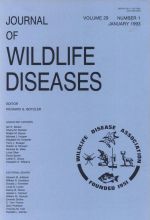Several features related to waterfowl carcasses were studied at Eyebrow Lake, Saskatchewan, Canada, during a botulism epizootic in the summer of 1989. Dummy carcasses, constructed by stretching duck skins over wooden forms, were used to assess the reaction of waterbirds to carcasses. There was no significant difference in the number of American coots, ducks, grebes, or total birds present when dummy carcasses were or were not present. Only one of 42 freshly-dead bird carcasses marked and observed twice each day was removed by a scavenger prior to the development of large maggots. Maggots developed in all carcasses and were visible externally a mean of 3.9 days after placement of the carcasses. The effectiveness of carcass collection and disposal operations was tested by marking carcasses on the day prior to two scheduled cleanups. Only 32% of marked carcasses were recovered. Large carcasses and carcasses on or near islands were recovered at a higher frequency than were small carcasses and carcasses not near islands, respectively.
How to translate text using browser tools
1 January 1993
OBSERVATIONS ON WATERFOWL CARCASSES DURING A BOTULISM EPIZOOTIC
D. J. Cliplef,
G. Wobeser

Journal of Wildlife Diseases
Vol. 29 • No. 1
January 1993
Vol. 29 • No. 1
January 1993
botulism
carcass
management
scavenging
waterfowl




